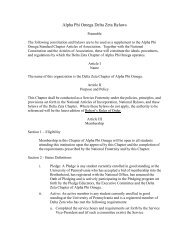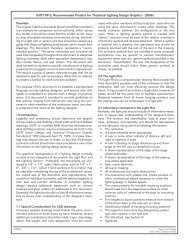Penn Philosophical Perspectives - University of Pennsylvania
Penn Philosophical Perspectives - University of Pennsylvania
Penn Philosophical Perspectives - University of Pennsylvania
- No tags were found...
You also want an ePaper? Increase the reach of your titles
YUMPU automatically turns print PDFs into web optimized ePapers that Google loves.
tractor regions, such as the convection cells. This model maylook entirely unlike the micro-dynamical equations, but this isirrelevant as long as it accurately describes the genesis and life-may have many more in the case <strong>of</strong> other systems. These oughtthen to be combined into a single class <strong>of</strong> models, designed tobe tailored to the situation at hand. a step, and that we still must learn how to decide into whichattractor the system evolves, even if only so that we learn topick the correct model from the class. I do not dispute this insolution may give us insight into this. In addition to creating aclass <strong>of</strong> models for each system, I believe that we would ben- to be outside the realm <strong>of</strong> the lower-level models but that canstill provide valuable insight into the behavior <strong>of</strong> the system.standard heat conduction and the convection cells are consistentwith the underlying equations. However, the system is dis- are preferred to standard heat conduction. Taking into accounthigher-level constraints that may not be accessible to the underlyingdynamical equations may provide insight into why aTaking into account concerns <strong>of</strong> a fundamentally differentlevel than the underlying dynamics <strong>of</strong> the equations may seemso. In general, there are complex trade<strong>of</strong>fs between the general-ratinga wider set <strong>of</strong> behaviors tends to reduce the applicability<strong>of</strong> the model to any particular situation, while also creatingYet, science in general assumes that the most powerful theoriesexplain a wide variety <strong>of</strong> phenomena as different manifestations<strong>of</strong> some general class <strong>of</strong> interactions (consider the search for theThis drive for a powerful and universal description <strong>of</strong>behavior is particularly attractive in the case <strong>of</strong> complex systems.Such systems display a characteristic which, confusinglyenough, has been called universality, or the fact seeminglydifferent systems at many different levels exhibit very similartypes <strong>of</strong> behavior. For example, there are many systems withbifurcation points similar to T cHowever, to create a model so general that it explains both thecreation <strong>of</strong> the convection cells and many other complex phenomenawould probably sap the model <strong>of</strong> any real explanatorypower.There are very few theories that apply to such a wide class<strong>of</strong> systems, but I want to argue that taking such theories intoaccount may in fact unify many distinct models into one. Inthe case <strong>of</strong> the convection cells, the general theory that oughtto be included is that <strong>of</strong> the thermodynamics <strong>of</strong> dissipative sys- entropy to the surrounding environment, allowing the creationJanuary 2010<strong>Penn</strong> <strong>Philosophical</strong> <strong>Perspectives</strong><strong>of</strong> large-scale order that would otherwise be destroyed by thisvironment,we may be able to classify the convection cells asis much work on dissipative systems and their properties, I donot know <strong>of</strong> any work that tries to understand their structures as ingincorporated the thermodynamic element into our model,how do we know when to start applying it? In other words,when does a system become dissipative? Clearly the Rayleigh-sipativebefore that? The answer must lie in the fact that dissipativesystems are ‘far from equilibrium,’ however no hardincorporating more general or higher-level constraints on ourmodels may complicate the situation, but I believe that enoughmay create a harder problem to solve mathematically, I believethat we will gain a clearer and more general overall picture <strong>of</strong>both the complex system at hand and complex phenomena ingeneral.These more complex models may require search through lems.However, despite fundamental limits on measurement ac-made to create better models <strong>of</strong> complex systems. The most architecture designed for molecular dynamics simulations,which works on the order <strong>of</strong> microseconds as opposed to theare very powerful, but lack any sort <strong>of</strong> general applicability.Hopefully, continued improvements in such systems combinedwith a reworking <strong>of</strong> the general structure <strong>of</strong> our models willprovide us with usable techniques for understanding even themost complex <strong>of</strong> phenomena.Works CitedAtlas.Cambridge <strong>University</strong>, Cambridge, 2007A Comparison <strong>of</strong> the Meanings and Uses <strong>of</strong>Models in Mathematics and the Empirical Sciences. Physics and Chance: <strong>Philosophical</strong> Issues in theFoundations <strong>of</strong> Statistical Mechanics. Cambridge Three Kinds <strong>of</strong> IdealizationOrder Out <strong>of</strong> Chaos:Man’s New Dialogue With NatureYork, 1984.Nonlinear Dynamics and Chaos. Perseus, Anton a Special-Purpose Machine forMolecular Dynamics Simulation. Communications <strong>of</strong> the 14
















